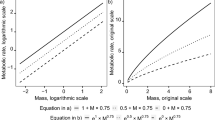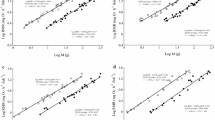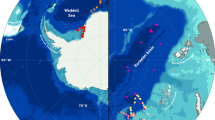Abstract
High interstage variability in body length and mass, reproductive state, and metabolic activity is characteristic of copepod populations from the Barents Sea and coastal waters in Sweden and Norway. The dry weight of a given copepodite stage, sampled at a given time from a homogeneous water mass, may vary by a factor of 4–5 between extreme individuals, protein and particularly lipid content being even more variable. Similarly, high variability in gut fullness and grazing rate within defined copepodite stages typically occurs at all times of the year, both when measured as in situ rate or experimentally determined rate, using homogeneous food suspensions. In accordance with this, maturation state (measured as length of gonads) and spawning (measured as rate of egg production over 24 h) are highly variable factors at the individual level. Since all these factors also influence the metabolic rate of the animals the respiratory rate (measured as ETS activity) of comparable individuals may vary by a factor of 5 or more. The results indicate that high individual variability in size and activity parameters is universal. This can not be explained by existing models of feeding behaviour, growth and development, and calls for new models, in which the nutritional history of the individual may play an important role.
Similar content being viewed by others

References
Alcaraz, M., G. -A. Paffenhöfer & J. R. Strickler, 1980. Catching the algae: a first account of visual observations on filter feeding calanoids. In W. C. Kerfoot (ed.), The evolution and ecology of zooplankton communities. The University Press of New England, Hanover (N. H.): 241–248.
Båmstedt, U., 1975. Studies on the deep-water pelagic community of Korsfjorden, western Norway. Ecological aspects of individual variations in weight and protein and lipid content of Euchaeta norvegica (Copepoda). Sarsia 59: 31–46.
Båmstedt, U.,1979. Seasonal variation in the respiratory rate and ETS activity of deep-water zooplankton from the Swedish west coast. In E. Naylor & R. G. Hartnoll (eds), Cyclic phenomena in marine plants and animals. Pergamon Press, Oxford: 267–274.
Båmstedt, U., 1980. ETS activity as an estimator of respiratory rate of zooplankton populations. The significance of variations in environmental factors. J. exp. mar. Biol. Ecol. 42: 267–283.
Båmstedt, U., 1984. Diel variations in the nutritional physiology of Calanus glacialis from lat. 78°N in the summer. Mar. Biol. 79: 257–267.
Båmstedt, U. & A. Ervik, 1984. Local variations in size and activity among Calanus finmarchicus and Metridia longa (Copepoda, Calanoida) overwintering on the west coast of Norway. J. Plankton Res. 6: 843–857.
Båmstedt, U. & K. S. Tande, 1985. Respiration and excretion rates of Calanus glacialis in arctic waters of the Barents Sea. Mar. Biol. 87: 259–266.
Boyd, C. M., 1976. Selection of particle sizes by filter-feeding copepods: a plea for reason. Limnol. Oceanogr. 21: 175–180.
Corkett, C. J. & I. A. McLaren, 1969. Egg production and oil storage by the copepod Pseudocalanus in the laboratory. J. exp. mar. Biol. Ecol. 3: 90–105.
Corkett, C. J. & F. J. Zillioux, 1975. Studies on the effects of temperature on the egg laying of three species of calanoid copepods in the laboratory (Acartia tonsa, Temora longicornis and Pseudocalanus elongatus). Bull. Plankton Soc. Jap. 21: 77–85.
Dorsey, T. E., P. W. McDonald & D. A. Roels, 1977. A heated biuret-folin protein assay which gives equal absorbance with different proteins. Anal. Biochem. 78: 156–164.
Frost, B. W., 1972. Effects of size and concentration of food particles on the feeding and behavior of the marine planktonic copepod Calanus pacificus. Limnol. Oceanogr. 17: 805–815.
Frost, B. W., 1977. Feeding behavior of Calanus pacificus in mixtures of food particles. Limnol. Oceanogr. 22: 472–491.
Hakanson, J. L., 1984. The long and short term feeding condition in field-caught Calanus pacificus, as determined from the lipid content. Limnol. Oceanogr. 29: 794–804.
Kankaala, P. & S. Johansson, 1986. The influence of individual variation on length-biomass regressions in three crustacean zooplankton species. J. Plankton Res. 8: 1027–1038.
Kiørboe, T., F. Møhlenberg & K. Hamburger, 1985. Bioenergetics of the planktonic copepod Acartia tonsa: relation between feeding, egg production and respiration, and the composition of specific dynamic action. Mar. Ecol. Prog. Ser. 26: 85–97.
Kiørboe, T., F. Møhlenberg & Nicolajsen, 1982. Ingestion rate and gut clearence in the planktonic copepod Centropages hamatus (Lilljeborg) in relation to food concentration and temperature. Ophelia 21: 181–194.
Koehl, M. A. R. & J. R. Strickler, 1981. Copepod feeding currents: food capture at low Reynolds number. Limnol. Oceanogr. 26: 1062–1073.
Mackas, D. & R. Bohrer, 1976. Fluorescence analysis of zooplankton gut contents and an investigation of diel feeding patterns. J. exp. mar. Biol. Ecol. 25: 77–85.
Marcus, N. H., 1985. Endogenous control of spawning in a marine copepod. J. exp. mar. Biol. Ecol. 91: 263–269.
Marshall, S. M. & A. P. Orr, 1972. The biology of a marine copepod. Reprint. Springer-Verlag. Berlin.
Matthews, J. B. L. & N. J. Sands, 1973. Ecological studies on the deep-water pelagic community of Korsfjorden, western Norway. The topography of the area and its hydrography in 1968–1972, with a summary of the sampling programmes. Sarsia 52: 29–52.
Mayzaud, P. 1976. Respiration and nitrogen excretion of zooplankton. 4. The influence of starvation on the metabolism and biochemical composition of some species. Mar. Biol. 37: 47–58.
McLaren, I. A. & C. J. Corkett, 1978. Unusual genetic variation in body size, development times, oil storage, and survivorship in the marine copepod Pseudocalanus. Biol. Bull. mar. biol. Lab., Woods Hole 155: 347–359.
Owens, T. G. & F. D. King, 1975. The measurement of respiratory electron-transport-system activity in marine zooplankton. Mar. Biol. 30: 27–36.
Paffenhöfer, G. -A. & K. B. Van Sant, 1985. The feeding response of a marine planktonic copepod to quantity and quality of particles. Mar. Ecol. Prog. Ser. 27: 55–65.
Parrish, K. K. & D. F. Wilson, 1978. Fecundity studies on Acartia tonsa (Copepoda: Calanoida) in standardized culture. Mar. Biol. 46: 65–81.
Pearre, S., Jr., 1974. Ecological studies of three west-Mediterranean chaetognaths. Inv. Pesq. 38: 325–369.
Pearre, S., Jr., 1979. Problems of detection and interpretation of vertical migration. J. Plankton Res. 1: 29–44.
Peterson, W. T., 1986. Development, growth, and survivorship of the copepod Calanus marshallae in the laboratory. Mar. Ecol. Prog. Ser. 29: 61–72.
Poulet, S. A. & P. Marsot, 1978. Chemosensory grazing by marine calanoid copepods (Arthropoda: Crustacea). Science N.Y. 200: 1403–1405.
Price, H. J. & G. -A. Paffenhöfer, 1986. Effects of concentration on the feeding of a marine copepod in algal monocultures and mixtures. J. Plankton Res. 8: 119–128.
Price, H. J., G. -A. Paffenhöfer & J. R. Strickler, 1983. Modes of cell capture in calanoid copepods. Limnol. Oceanogr. 28: 116–123.
Raymont, J. E. G., 1983. Plankton and productivity of the oceans. 2nd edition. 2. Zooplankton. Pergamon Press, Oxford.
Runge, J. A., 1984. Egg production of the marine, planktonic copepod, Calanus pacificus Brodsky: Laboratory observations. J. exp. mar. Biol. Ecol. 74: 53–66.
Skjoldal, H. R., U. Båmstedt, J. Klinken & A. Laing, 1984. Changes with time after capture in the metabolic activity of the carnivorous copepod Euchaeta norvegica Boeck. J. exp. mar. Biol. Ecol. 83: 195–210.
Strickland, J. D. H. & T. R. Parsons, 1972. A practical handbook of seawater analysis. Bull. 167, 2nd ed., Fish. Res. Bd Canada, Ottawa.
Strickler, J. R., 1982. Calanoid copepods, feeding currents, and the role of gravity. Science N.Y. 218: 158–160.
Tande, K. S. & C. C. E. Hopkins, 1981. Ecological investigations on the zooplankton community of Balsfjorden, northern Norway. The genital system in Calanus finmarchicus and the role of gonad development in overwintering strategy. Mar. Biol. 63: 159–164.
Tande, K. S. & U. Båmstedt, 1985. Grazing rates of the copepods Calanus glacialis and C. finmarchicus in arctic waters of the Barents Sea. Mar. Biol. 87: 251–258.
Uye, S. -I., 1981. Fecundity studies of neritic calanoid copepods Acartia clausi Giesbrecht and A. steueri Smirnov: a simple empirical model of daily egg production. J. exp. mar. Biol. Ecol. 50: 255–271.
Van Alstyne, K. L., 1986. Effects of phytoplankton taste and smell on feeding behavior of the copepod Centropages hamatus. Mar. Ecol. Prog. Ser. 34: 187–190.
Wilson, D. F. & K. K. Parrish, 1971. Remating in a planktonic marine calanoid copepod. Mar. Biol. 9: 202–204.
Author information
Authors and Affiliations
Rights and permissions
About this article
Cite this article
Båmstedt, U. Ecological significance of individual variability in copepod bioenergetics. Hydrobiologia 167, 43–59 (1988). https://doi.org/10.1007/BF00026293
Issue Date:
DOI: https://doi.org/10.1007/BF00026293



